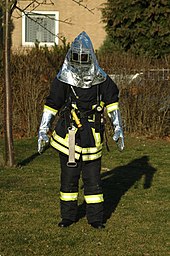Heat protective clothing
Heat protection clothing or heat protection suits or heat protection clothing (abbreviation: WSK) (English: fire proximity suit or hot suit ) serve to protect personnel from extreme heat radiation ( thermal risks ), for example fire departments in the event of very hot fires , but also metal workers who work with highly heated metals ( Blast furnace, welding shop, smelters ), or chemical industry workers ( handling of polymerisation, etc. ) or in similar working environments ( e.g. boiler systems ) in areas of human-machine systems .
Heat protective clothing should protect against thermal risks.
Thermal risks are flames, contact heat, radiant heat, sparks, flammable media as well as hot gases and vapors. The protective effect of the clothing must be maintained during the exposure, that is, the clothing must be self-extinguishing, it must neither melt nor shrink.
Heat protection clothing consists of a multi-layer, insulating inner suit (usually aramids, imides or duromers) and a metal coating (usually aluminum-vaporized) that keeps heat radiation away from the body. According to an earlier form, the term “ asbestos suit ” was often used colloquially .
The heat protection suit usually has a gold-coated lens.
Areas of application for the protective suit of the fire brigade are all positions with unusually strong heat radiation, for example fires in chemical plants, on oil production systems or tank trucks . In principle, the heat protection could also be used for fire fighting or for rescuing people.
This "silver" heat protection is used in three forms by the fire service:
- Form I: gloves with gauntlets and protective hood (rarely found today)
- Form II: coat with integrated protective hood and gloves
- Form III: one or two-piece full-body suit with integrated protective hood, gloves and socks.
For regular industrial use, there are also more special protective devices, such as aprons, head visors, shields, etc.
See also
Web links
Individual evidence
- ↑ Information about heat protection clothing. German Social Accident Insurance eV (DGUV), accessed on October 11, 2019 .


